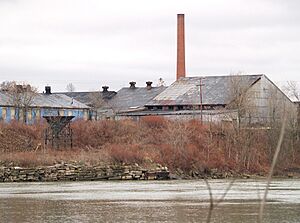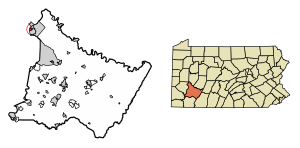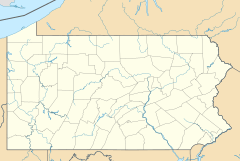Arnold, Pennsylvania facts for kids
Quick facts for kids
Arnold, Pennsylvania
|
|
|---|---|

Abandoned factory along the Allegheny River
|
|
| Motto(s):
Proud City of Proud People
|
|

Location of Arnold in Westmoreland County, Pennsylvania.
|
|
| Country | United States |
| State | Pennsylvania |
| County | Westmoreland |
| Settled | 1781 |
| Incorporated (borough) | 1896 |
| Incorporated (city) | 1939 |
| Area | |
| • Total | 0.85 sq mi (2.21 km2) |
| • Land | 0.73 sq mi (1.90 km2) |
| • Water | 0.12 sq mi (0.31 km2) |
| Population
(2020)
|
|
| • Total | 4,772 |
| • Density | 6,519.13/sq mi (2,516.92/km2) |
| Time zone | UTC-5 (Eastern (EST)) |
| • Summer (DST) | UTC-4 (EDT) |
| FIPS code | 42-03088 |
Arnold is a city in Westmoreland County, Pennsylvania, United States. It is part of the larger Greater Pittsburgh area. In 2010, about 5,157 people lived there.
Contents
History of Arnold
The land where Arnold is today was once a hunting area for the Iroquois Native American tribe. Around 1750, European colonists started moving into the region. In 1781, a man named Robert McCrea bought the land. Later, it was owned by William Jack and then Wilson Jack.
The first permanent settlers arrived in 1852. One of them was Major Andrew Arnold, who grew up in Kittanning. The city was named after his family.
When Westmoreland County was created in 1773, Arnold was part of Burrell Township. Later, it became part of Lower Burrell Township. From 1891 to 1896, Arnold was part of the city of New Kensington.
In January 1896, Arnold became its own separate borough. Then, in 1939, it officially became a "third-class city." This means it has a special way of being governed. The city is led by a mayor, a treasurer, a controller, and four council members. They are all elected by the people of Arnold.
Some past mayors include M. Frank Horne, Alfred Colaianni, and Willie DeMao. More recently, John Campbell and Larry Milito served as mayors. In 2016, Karen Peconi-Biriccochi became mayor. In 2018, during public protests, some of her social media comments caused controversy. Many people asked her to step down. The city council even asked the state government to remove her. In 2019, she lost the election to Joseph Bia II, who became mayor in 2020. In 2024, Shannon Santucci took office as the new mayor.
Geography of Arnold
Arnold is located on the eastern side of the Allegheny River. It is northeast of the big city of Pittsburgh. The U.S. Census Bureau says Arnold covers about 0.8 square miles (2.21 square kilometers). Most of this area is land, and a small part is water.
Neighboring Areas
Arnold shares its land borders only with New Kensington. New Kensington is to Arnold's north, east, and south. Across the Allegheny River, Arnold is next to East Deer Township in Allegheny County.
People of Arnold
| Historical population | |||
|---|---|---|---|
| Census | Pop. | %± | |
| 1900 | 1,428 | — | |
| 1910 | 1,818 | 27.3% | |
| 1920 | 6,120 | 236.6% | |
| 1930 | 10,575 | 72.8% | |
| 1940 | 10,898 | 3.1% | |
| 1950 | 10,263 | −5.8% | |
| 1960 | 9,437 | −8.0% | |
| 1970 | 8,174 | −13.4% | |
| 1980 | 6,853 | −16.2% | |
| 1990 | 6,113 | −10.8% | |
| 2000 | 5,667 | −7.3% | |
| 2010 | 5,157 | −9.0% | |
| 2020 | 4,772 | −7.5% | |
In the year 2000, there were 5,667 people living in Arnold. There were 2,589 households, which are groups of people living together. About 1,439 of these were families. The city had many different groups of people living there. Most residents were White, and about 12.76% were African American.
About 23.6% of households had children under 18. Many households were made up of married couples. Some households had a single parent, usually a mother. About 39.9% of all households were people living alone. Many of these were people aged 65 or older.
The average age of people in Arnold was 40 years old. About 21.6% of the population was under 18. About 22.6% of people were 65 or older.
In 2000, the average income for a household in Arnold was $26,190 per year. For families, the average income was $32,569. About 17.7% of all people in Arnold lived below the poverty line. This means they were struggling financially.
Famous Places in Arnold
Arnold has had several important landmarks over the years:
- Arnold Station: This was a railroad stop built in 1867. The land for it was given by the Arnold family.
- The Chambers Glass Company: This factory opened in 1891. It was known for being one of the best glass factories in the country at that time.
- George Moore Home: This was a very large, 17-room house. It was taken down in the 1960s.
- The Morris Davis Home: This was one of the first private homes in the area to have electricity. Morris Davis built it very carefully, choosing only perfect wood.
- Eiler Hall: This building was a popular place for parties, dances, and public shows. Today, it's a parking lot for city workers.
- The Edna Hotel: Named after George Moore's daughter, this hotel was built in the 1890s. It was a central meeting spot for everyone in Arnold around the year 1900. A big fire destroyed the building in the late 1990s.
- The John Fedan Store: This started as a space for other businesses to rent. It grew into a hardware store, and later sold furniture and appliances.
- The Arnold Drug Store: This store opened in 1898. It also served as the local post office for a while.
Education in Arnold
Students in Arnold attend schools in the New Kensington–Arnold School District. This district includes four schools located in both New Kensington and Arnold.
- Valley Jr/Sr High School
- Roy A. Hunt Elementary School (in Arnold)
- H.D. Berkey School (in Arnold)
- Martin Elementary School (in New Kensington)
The building that is now Roy A. Hunt Elementary School used to be Arnold's high school. This was before the school districts merged. After the merge, it became Valley Middle School. Since 2012, it has been an elementary school for grades 3-6.
Notable People from Arnold
Some famous people who came from Arnold include:
- Clara Chiano (1921–2000), a player in the American Girls Professional Baseball League.
- Johnny Costa (1922–1996), a talented jazz pianist.
- Fannie Sellins (1872–1919), a person who worked to improve conditions for workers.
See also
 In Spanish: Arnold (Pensilvania) para niños
In Spanish: Arnold (Pensilvania) para niños



